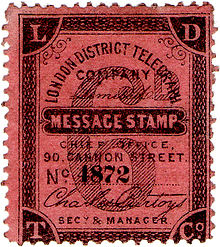The British and Irish Magnetic Telegraph Company (also called the Magnetic Telegraph Company or the Magnetic) was founded by John Brett in 1850. The Magnetic was the principal competitor to the largest telegraph company in the United Kingdom, the Electric Telegraph Company (the Electric). The Magnetic was the leading company in Ireland, while the Electric was the leading company in mainland Britain. Between them, they dominated the market until the telegraph was nationalised in 1870.
The Magnetic's telegraph system differed from other telegraph companies. They favoured underground cables rather than wires suspended on poles. This system was problematic because of the limitations of insulation materials available at the time, but the Magnetic was constrained by the wayleaves owned by other companies on better routes. They were also unique in not using batteries which were required on other systems. Instead the operator generated the necessary power electromagnetically. The coded message was sent by the operator moving handles which moved coils past a permanent magnet thus generating telegraph pulses.
The Magnetic laid the first submarine telegraph cable to Ireland and developed an extensive telegraph network there. They had a close connection with the Submarine Telegraph Company and for a while had a monopoly on underwater, and hence, international communication. They also closely cooperated with the London District Telegraph Company who provided a cheap telegram service in London. The Magnetic was amongst the first to employ women as telegraph operators.
https://en.wikipedia.org/wiki/British_and_Irish_Magnetic_Telegraph_Company
The London District Telegraph Company was formed in 1859. It was renamed the London and Provincial Telegraph Company in 1867.[1]
The management were connected with the British and Irish Magnetic Telegraph Company and the firm aimed to compete with the dominant Electric Telegraph Company in the London area. Its original Chairman was the banker and Member of Parliament Samuel Gurney (1816–1882).[2] It used a combination of underground and overhead wires and saved money by avoiding the need for an Act of Parliament to authorise its activities. The overhead wires, however, required negotiation with individual households and landowners and were vulnerable to damage in bad weather. The firm employed many female clerks who were supervised by a "Matron" and "Sub Matrons".
In 1860 the company agreed with the Astronomer Royal to relay the Greenwich Observatory time-signal to all of its offices.[1]
Despite an extensive network of lines in London, the company never made a net profit and only once an operating profit. It was acquired by the Postmaster General in the general nationalisation of private telegraph companies under the Telegraph Act 1868.[1]
The company issued a number of telegraph stamps which are of interest to philatelists.[3]
https://en.wikipedia.org/wiki/London_District_Telegraph_Company
https://en.wikipedia.org/wiki/Sound_Broadcast_Services
https://en.wikipedia.org/wiki/Submarine_Telegraph_Company
The Universal Private Telegraph Company, Limited was formed in 1861[1] to exploit Professor Charles Wheatstone’s 1858 Universal Telegraph. The company was meant to "carry out a system by which banks, merchants, public bodies and other parties may have the means of establishing a telegraph for their own private purposes from their houses to their offices, manufactories or other places".[2]
The company's first directors were Charles Wheatstone and William Fairbairn, CE, the Manchester ironmaster. It employed Thomas Page as the engineer, Lewis Hertslet as the secretary, and Nathaniel Holmes as the electrician.[2]
Archives
As a nationalised company, the firm's records are now in the British Telecom Archives.
Stamps
The company issued a number of stamps which are of interest to philatelists and are still some of the most common British telegraph stamps found. It is unclear, however, whether the stamps were ever used as only unused copies are known of. The stamps mentioned the year in the corners.[3]
https://en.wikipedia.org/wiki/Universal_Private_Telegraph_Company
https://en.wikipedia.org/wiki/India_Rubber,_Gutta_Percha_and_Telegraph_Works_Company
https://en.wikipedia.org/wiki/Charles_Macintosh
https://en.wikipedia.org/wiki/Joseph_Black



No comments:
Post a Comment